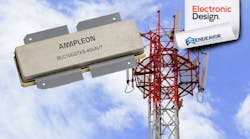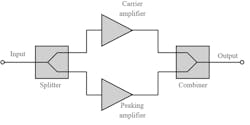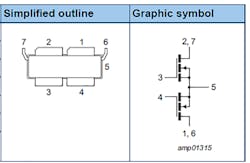2.5-GHz Amp Implements 400-W Asymmetric Doherty Architecture
This article appeared in Electronic Design and has been published here with permission.
The Doherty amplifier—a modified Class B topology—has been in use for many years. It was developed by William H. Doherty of the renowned Bell Telephone Laboratories in 1936 to accommodate signals with high peak-to-average power ratios. It used two amplifier circuits in an asymmetric arrangement, with a lower-power carrier amplifier and higher-power peaking amplifier within the overall amplifier (Fig. 1). (Note: this “Class B” is unrelated to another popular “Class B” rating for conducted and radiated EMC requirements of EN55022-B and FCC Class B standards.)
Unlike standard Class B amplifiers that can “clip” more than is acceptable at high input-signal levels, the Doherty amplifier achieves a high level of linearity while retaining good power efficiency. It’s been used in implementations from low power to some as high as 50,000 W. In recent decades, interest has increased in the Doherty approach for base stations and other situations where its ability to balance the conflicting requirements and tradeoffs for linearity and efficiency is a major benefit.
To encourage use of this approach in the lower gigahertz region, Ampleon introduced the BLC10G27XS-400AVT, a 400-W asymmetric Doherty RF power transistor targeting base-station multi-carrier applications from 2.496 to 2.690 GHz. The LDMOS device provides power gain of 13.3 dB with typical drain efficiency of 45%. This electrically rugged power amplifier handles VSWR mismatches as high as 10:1, an important factor for base-station applications that often experience extreme-mismatch conditions.
This power amp (PA) also features integrated ESD protection, has a low output capacitance for improved Doherty performance, and includes internal input and output impedance transformation, thus enabling easier PCB matching to 50-Ω interfaces. It’s housed in a six-lead, air-cavity plastic (ACP), “earless” SOT-1258-4 package that offers low thermal resistance for enhanced excellent thermal stability (Fig. 2).
Of course, every PA needs a driver, and Ampleon offers the BLM9D2327S-50PB MMIC, itself a Doherty-topology device. The 15-page BLC10G27XS-400AVT datasheet includes the PCB layout for a test circuit with call-out of the special PCB material and full bill of materials. Further vendor support includes simulation models, application notes, and white papers such as the 14-page “Doherty Architectures in UHF.”
There’s even an RF power transistor lifetime calculator that allows designers to enter data about operating conditions and returns an estimate of factors such as anticipated junction temperature and mean time to failure (MTTF).


